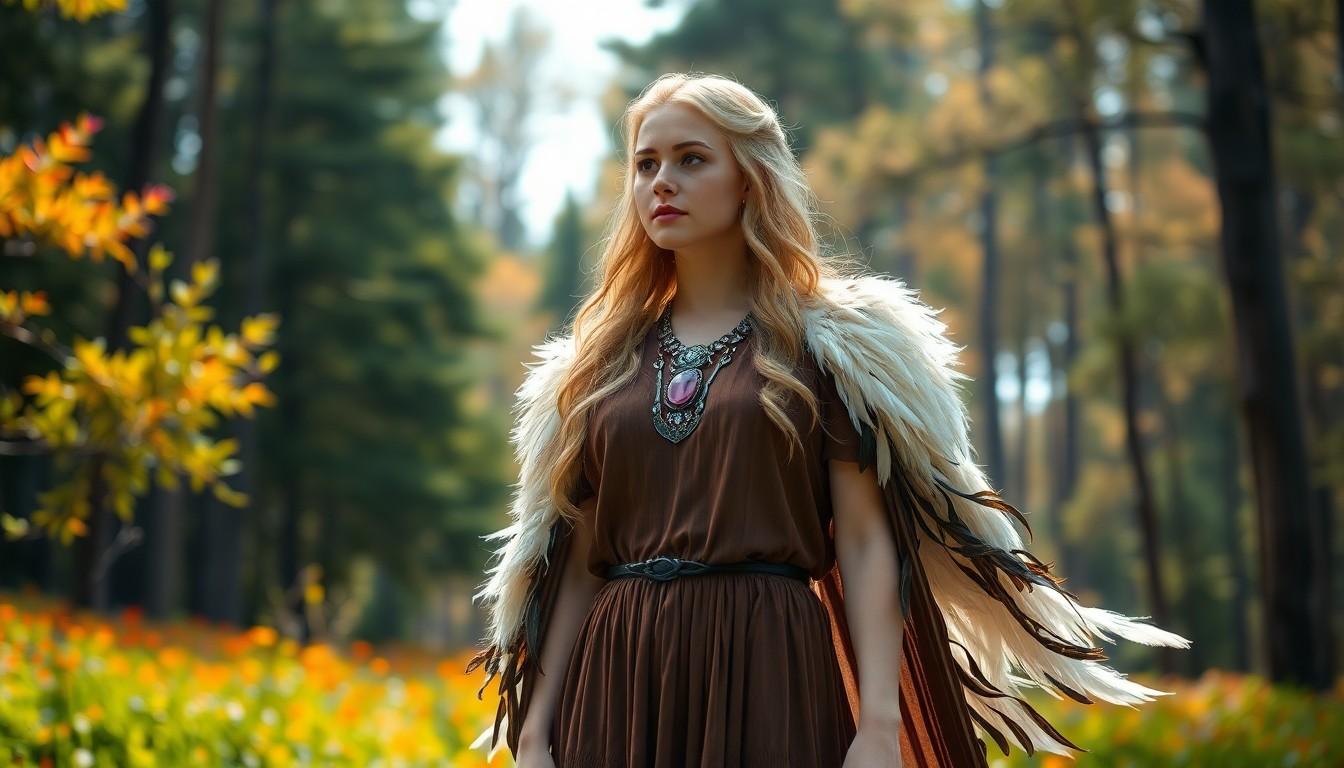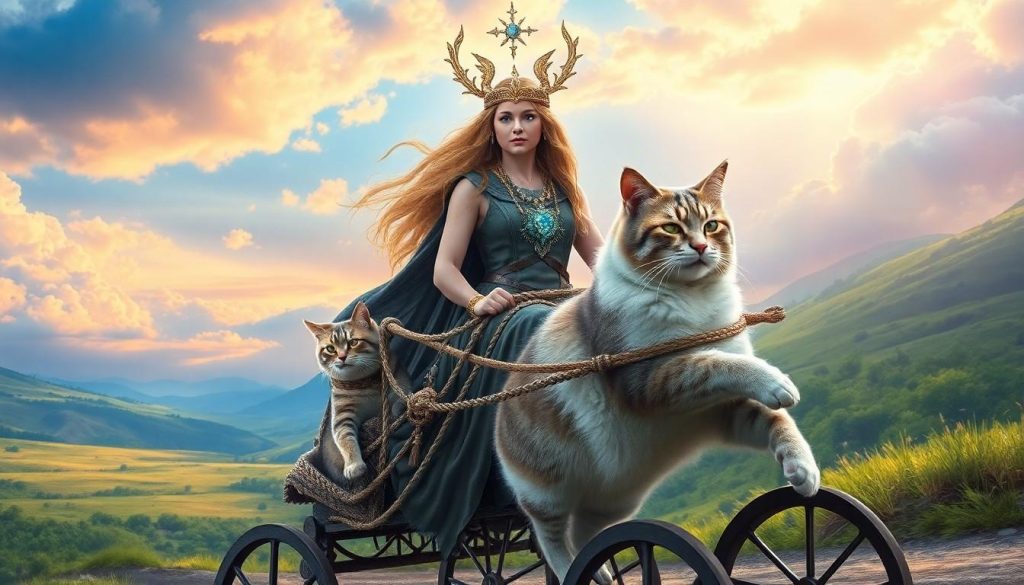In Norse mythology, Freya is one of the most powerful and captivating deities. As the goddess of love, beauty, fertility, and war, she embodies a complex blend of attributes that have fascinated people for centuries. Her influence extends far beyond the ancient Nordic tales, reaching into modern culture and spiritual practices.
Freya’s compelling story weaves through the fabric of Norse mythology, where she rides her chariot pulled by two magical cats and wears her famous Brisingamen necklace. Known for her mastery of seidr magic and her role as the leader of the Valkyries, she’s earned her place among the most revered figures in the Norse pantheon. Today, her legacy inspires artists, writers, and those drawn to Norse spirituality, making her one of the most recognized goddesses in contemporary pagan traditions.
Who Is Freya in Norse Mythology?
Freya is one of the most revered deities in Norse mythology. She embodies power over love, fertility, sex, war, and death magic. Her name, derived from Old Norse, translates to “Lady” or “Mistress,” reflecting her elevated status among the gods.
Origins and Family Lineage
Freya emerges from the noble Vanir tribe of deities, distinguished from the warrior-focused Aesir gods. She’s the daughter of Njord, the mighty god of sea and prosperity. Her twin brother Freyr shares her divine heritage, while her mother remains unnamed in Norse texts despite being Njord’s sister. This divine lineage establishes Freya’s position as a central figure in the Norse pantheon, connecting her to earthly abundance and marine influence.
Freya’s Divine Domains and Powers
Freya commands an extensive range of divine attributes that showcase her multifaceted nature. As the goddess of love, fertility, and beauty, she governs matters of the heart, sexual energy, and procreation. Her martial aspects manifest in her role as a battle deity, where she claims half of all fallen warriors for her hall, Sessrúmnir. Through her mastery of seidr magic, she can shape destiny, weave spells, and perform divination. These combined powers demonstrate her influence over life and death, making her a formidable force in Norse cosmology.
| Domain | Associated Powers |
|---|---|
| Love | Romance, passion, attraction |
| Fertility | Procreation, abundance, growth |
| War | Battle prowess, warrior selection |
| Magic | Seidr, prophecy, spellcraft |
| Death | Afterlife guidance, soul collection |
The Many Names and Titles of Freya

Freya holds numerous titles and names in Norse mythology, reflecting different aspects of her divine nature and powers. These names showcase her multifaceted role as a goddess and her significance in Norse culture.
Lady of the Vanir
Freya’s title, “Vanadís,” translates to “Lady of the Vanir,” marking her as a prominent member of the Vanir tribe of gods. As a Vanir goddess, she represents the older generation of Norse deities associated with nature, fertility, and prosperity. Her connection to the Vanir establishes her divine lineage and distinguishes her from the Æsir gods.
Goddess of Love and Beauty
The name “Freyja,” meaning “Lady” or “Woman” in Old Norse, connects directly to her role as the goddess of love and beauty. Her alternative names—Gefn, Hörn, Mardöll, and Sýr—emphasize different aspects of her beauty and allure. The title “Valfreyja” highlights her authority in selecting fallen warriors for her great hall, Fólkvangr, combining her aspects of love and martial power.
Freya’s Magical Possessions

Freya’s divine power manifests through her two most prized magical possessions: the legendary Brisingamen necklace and a remarkable feathered cloak.
The Brisingamen Necklace
The Brisingamen necklace is the most exquisite piece of jewelry in Norse mythology. Four skilled dwarven craftsmen forged this magnificent necklace, which Freya acquired by spending one night with each dwarf after they rejected her offers of gold and silver. The necklace’s history includes a dramatic theft by Loki, who transformed into a fly to infiltrate Freya’s locked dwelling and then became a flea to access the necklace’s clasp. Odin later returned the Brisingamen to Freya after she cast a spell that cursed two kings to eternal combat.
Her Feathered Cloak
The falcon-feather cloak represents Freya’s mastery over flight and transformation. This mystical garment enables her to soar through the skies at will, demonstrating her connection to earthly and celestial realms. Other Norse deities occasionally borrow this mighty artifact, highlighting its significance in divine matters and Freya’s influence among the gods.
Freya’s Role in Norse Tales and Legends

Freya emerges as a central figure in Norse mythology, wielding influence over love, beauty, fertility, sex, war, gold, and seiðr magic. Her diverse roles and captivating tales establish her as one of the most significant deities in Norse mythology.
The Loss of Odr
The tale of Freya’s husband, Odr, is one of the most poignant stories in Norse mythology. Odr’s mysterious disappearance prompted Freya to search the nine worlds extensively, shedding tears of red gold that transformed into amber upon touching the earth. Her relentless pursuit exemplifies the depth of her emotional capacity, adding a layer of complexity to her character beyond her roles as a warrior and fertility goddess.
Battle for Brisingamen
The acquisition and defense of the Brisingamen necklace demonstrates Freya’s determination and cunning nature. Four dwarven craftsmen created this magnificent piece of jewelry, which Freya obtained through strategic negotiations. Loki’s attempt to steal the necklace by transforming it into a fly led to a fierce confrontation, culminating in Heimdall’s intervention to retrieve the precious ornament. The tale interweaves themes of desire, deception, and divine intervention, highlighting Freya’s complex relationships with treasures and other deities in the Norse pantheon.
| Aspect | Details |
|---|---|
| Divine Domains | Love, Beauty, Fertility, War, Gold, Seiðr |
| Sacred Realm | Fólkvangr |
| Notable Possession | Brisingamen Necklace |
| Warriors’ Division | 50% to Fólkvangr, 50% to Valhalla |
Modern Worship and Cultural Impact
Freyja’s influence extends beyond ancient Norse mythology into contemporary spiritual practices and popular culture. Her multifaceted nature as a goddess of love, magic, and war continues to resonate with modern practitioners and artists.
Neo-Pagan Practices
Contemporary neopagan traditions honor Freyja through diverse spiritual practices. Modern Heathens recognize her as a patron deity for magic, fertility rituals, and personal development. Rural Scandinavian communities preserve her connection to fertility traditions, particularly during the Midsommerstangen celebrations at Summer Solstice, which feature traditional dances around a maypole-like structure.
Popular Culture References
Freyja’s compelling character appears across various modern media formats:
- Video Games: Featured in games like “God of War” (2018) and “Vikings: War of Clans”
- Literature: Portrayed in Neil Gaiman’s “Norse Mythology” and other contemporary fantasy novels
- Television: Represented in series like “American Gods” and “Vikings”
- Music: Referenced in Nordic folk metal bands’ lyrics, including Amon Amarth and TYR
- Art: Depicted in contemporary digital art collections and traditional paintings showcasing her with her cats, necklace, and falcon cloak
Conclusion
Freya is one of the most captivating and influential figures in Norse mythology. Her multifaceted nature as a goddess of love, beauty, fertility, and war continues to resonate with people worldwide. Through her magical artifacts, legendary tales, and enduring influence, she represents the perfect balance of power and grace.
Modern interpretations across various media platforms have kept Freya’s legacy alive while staying true to her mythological roots. Her worship in contemporary pagan practices and her ongoing influence in popular culture demonstrate that this powerful Norse goddess remains as relevant today as she was centuries ago.

